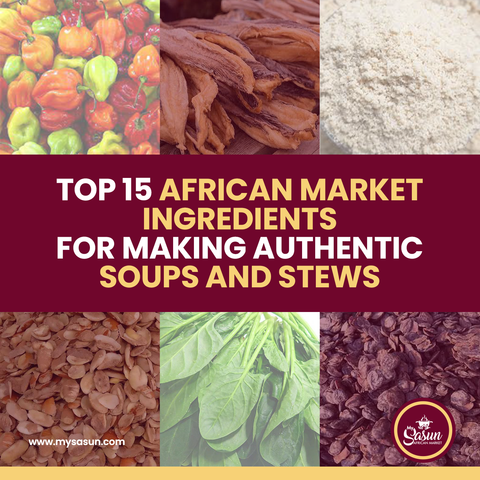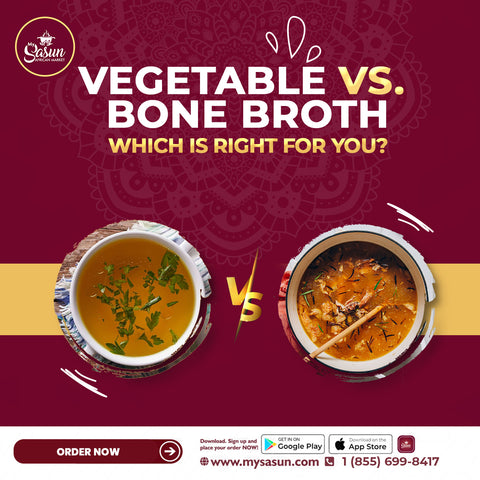Also Read: 10 Delicious African Soups and Stews That Pair Well with Fufu
1. Palm Oil
Palm oil is the foundation of many West African soups and stews. It has a bold, earthy flavor and gives dishes that signature red color. Whatever you're making- Egusi, Ogbono, beans stew or Banga soup, palm oil is what brings everything together. It adds a richness that other oils can’t match.
Common Uses:
2. Ground Egusi (Melon Seeds)
Egusi seeds, ground into a fine powder, add a creamy texture and a nutty flavor to soups that makes them rich and hearty. Plus, they’re packed with protein, so they’re perfect for making a filling meal.
Common Uses:
- Egusi Soup, Vegetable Stew
Also Read: Two Authentic Methods of Cooking Egusi Soup
3. Ground Crayfish
Ground crayfish is one of those secret ingredients that gives African soups that extra “oomph.” It’s packed with umami, that savory, mouthwatering taste, and adds a seafood flavor without overpowering the dish. A little goes a long way in soups like Ogbono and Bitter Leaf.
Common Uses:
- Ogbono Soup, Egusi Soup, Afang Soup, Bitter Leaf Soup
Also Read: The Importance of Iron-Rich Foods in your Pregnancy Diet
4. Stockfish (Dried Fish)
Stockfish, often dried cod or haddock, is a must in many African stews. Its intense salty flavor infuses the soup as it rehydrates during cooking. It’s especially great in soups like Banga or Bitter Leaf, where the fish complements the richness of the broth.
Common Uses:
- Banga Soup, Afang Soup, Bitter Leaf Soup
5. Goat Meat
Goat meat is a favorite in many African soups and stews because of its rich, gamey flavor. Whether slow-cooked in Pepper Soup or simmered in a pot of Banga, friend or roasted, goat meat brings a deep, savory taste that’s perfect for great meals.
Common Uses:
- Goat Meat Stew, Pepper Soup, Banga Soup
6. Maggi or Knorr Stock Cubes
Let’s be honest—no African kitchen is complete without Maggi or Knorr stock cubes. They’re an easy way to add flavor, making sure your soup or stew is rich and well-seasoned. Whether it’s Egusi, Ogbono, or a simple stew, these cubes are the backbone of many dishes.
Common Uses:
- Egusi Soup, Ogbono Soup, Pepper Soup
7. Scotch Bonnet Peppers
These tiny peppers pack a punch! Scotch bonnet peppers bring serious heat and a fruity undertone to African dishes. If you love the fiery kick of Pepper Soup or the spiciness in Groundnut Stew, Scotch bonnets are the secret behind that heat.
Common Uses:
- Pepper Soup, Fish Stew, Groundnut Stew
8. Ogbono Seeds (Wild Mango Seeds)
Ogbono seeds are what give Ogbono Soup its signature "slimy" texture. Ground into a powder, these seeds thicken the soup and add a mildly nutty flavor. If you’ve ever dipped eba or fufu into a bowl of Ogbono, you’ll know why this is an essential ingredient in an African home.
Common Uses:
- Ogbono Soup, Draw Soup
9. Vegetable Leaves
In African soups and stews, leafy greens are essential for both flavor and nutrition. Depending on the region, different types of leaves are used to bring texture, freshness, and unique flavors to the dish. Here are some common vegetable leaves:
- Ugu (Fluted Pumpkin Leaves): Used in soups like Egusi and Ogbono, known for their mild flavor.
- Waterleaf: Commonly used in Afang Soup for its slightly tangy taste and soft texture.
- Afang/Okazi Leaves: These fibrous leaves are popular in southeastern Nigerian dishes like Afang Soup.
- Bitter Leaf (Onugbu): Adds a slightly bitter taste to dishes like Bitter Leaf Soup, balancing rich ingredients like palm oil and meats.
Common Uses:
- Egusi Soup, Afang Soup, Ogbono Soup, Bitter Leaf Soup
10. Tomato Paste
Tomato paste is a key ingredient for building flavor in stews and soups. It provides a rich, tangy base for dishes like Fish Stew, pepper stew and Groundnut Stew. It also adds color and depth, giving the dish a well-rounded taste.
Common Uses:
- Fish Stew, Groundnut Stew, Jollof Rice, pepper stew
11. Vegetable Oil
While palm oil is popular, vegetable oil is also widely used in African cooking. It’s a lighter option for frying and sautéing vegetables or meats and works well in less deep dishes like Jollof Rice or lighter stews.
Common Uses:
- Jollof Rice, Stews, Frying meats and vegetables
12. Curry Powder
Curry powder, introduced to Africa through colonial influences, has become a key spice in many African stews. Its mix of spices brings warmth and complexity to dishes like Chicken Stew, Fish Stew, and Jollof Rice.
Common Uses:
- Chicken Stew, Fish Stew, Jollof Rice
13. Thyme
Thyme is an essential herb in many African kitchens, used for its earthy and slightly minty flavor. It’s a common ingredient in soups, stews, and sauces, adding a fragrant herbal note to dishes like Pepper Soup and Fish Stew.
Common Uses:
- Pepper Soup, Fish Stew, Goat Stew
14. Locust Beans (Iru or Ogiri)
Locust beans, known as Iru in Yoruba or Ogiri in Igbo, are fermented beans that add depth and a strong umami flavor to soups and stews. They are used in dishes like Ewedu Soup, Egusi, and Ogbono. They provide an earthy richness to soups.
Common Uses:
- Ogbono Soup, Egusi Soup, Ewedu Soup
15. Ground Pepper (Ata gigun)
Ground pepper, often a mix of dried chili peppers, is a key seasoning in African soups and stews. It adds heat and depth to dishes like Pepper Soup and Groundnut Stew, balancing the richness of palm oil and meats.
Common Uses:
- Pepper Soup, Egusi Soup, Fish Stew
Conclusion
Whatever soup or stew you’re making, having these essential ingredients on hand will help you recreate the authentic taste of home.
At My Sasun African Market, we’ve got everything you need to create these dishes, from stockfish to palm oil. So go ahead, stock up, and let the cooking begin! Your next delicious meal is just a pot away.
FAQs
Can I substitute palm oil with another oil?
While palm oil gives African soups a distinct flavor, you can substitute it with vegetable or coconut oil in a pinch. However, the flavor won’t be as rich or authentic.
What’s the best way to use stock cubes in soups?
Stock cubes should be dissolved in water or broth as the base of your soup. You can add them early in the cooking process to let the flavors blend with other ingredients.
Are Egusi and Ogbono interchangeable?
No, Egusi and Ogbono are two different ingredients with distinct flavors and textures. Egusi thickens soups, while Ogbono adds a slimy texture. They are not typically substituted for each other.
Can I make these soups vegetarian?
Yes! You can make vegetarian versions of these soups by substituting the meat with mushrooms, tofu, or extra vegetables. Use vegetable stock instead of meat-based broth.
Where can I find these ingredients?
You can find all of these ingredients at My Sasun African Market, either online or at our physical stores.
How long can I store these ingredients?
Ingredients like stockfish, ground crayfish, and locust beans can last for several months if stored in airtight containers in a cool, dry place. Fresh leaves and vegetables should be used within a week, or you can freeze them to extend their shelf life.
Can I use fresh tomatoes instead of tomato paste?
Yes, you can use fresh tomatoes, but you’ll need to cook them down longer to reduce the water content and concentrate the flavor. Tomato paste offers a more intense flavor and thicker consistency, which is why it's often preferred for stews.
What are some good side dishes to serve with African soups and stews?
Common side dishes include fufu, pounded yam, eba, starch, and garri. These starchy sides are perfect for dipping into soups and stews, helping to soak up all the rich, flavorful broth.
Are locust beans (iru) necessary for soups?While not mandatory, locust beans add a deep umami flavor to many traditional African soups, especially in Nigerian cuisine. If you’re looking for an authentic taste, they’re highly recommended.







Comments (4)
Am here to let the whole world know that I was diagnose of herpes 3 years ago where all hope was lost and I had nothing to do about it,I just accepted the faith that one day I will cure of this disease and I just pray everyday for a helper and one day my sister introduce me to a herbal doctor man called Dr ahonsie that she saw him on internet well I contact him on his email,I was not fully convinced until he sent me the herbal medicine which he ask me to take for two weeks I took it with faith and i went for a retest in different hospitals and today am cured of this disease and am also using this medium to let all those having STD,like herpes and the rest not to give up,their is a man who can cure you,his name is Dr ahonsie . contact the great herbalist via his Email: drahonsie00@gmail.com / WhatsApp: +2348039482367. https://drahonsie002.wixsite.com/dr-ahonsie
I would never have believed that cold sore herpes virus can be cured with ancient herbal medicine because I just tested negative for the second time since I finished drinking the medicine a herbal doctor sent to me, all the sores and blisters were gone immediately I started drinking the herbal meds, so I want you all to know that herpes virus can be cured with the right use of ancient herbal medicine so visit this herbalist called doctor excel on his Email: drahonsie00@gmail.com / WhatsApp: +2348039482367. https://drahonsie002.wixsite.com/dr-ahonsie https://www.facebook.com/drstellaherbalhome?mibextid=ZbWKwLThanks
My purpose out here today is to share this article to the world about how Doctor Odunga helped me in getting back my EX-boyfriend who broke up with me 4 months ago. I tried all I could to make him see reasons with me so that we can continue our relationship but he denied me. Thank God for giving me the thought of going into the internet for help, I searched properly and I saw different reviews of Doctor Odunga and I insisted on giving it a try by contacting him via what’s app on (+2348167159012). He gave me reason to live again and he prepared a spell and told me that my Ex-boyfriend will come back to me within 11 hours. Can you believe it, my EX-boyfriend came back to me, proposed to me and our wedding will be held soon. Contact him now!!! if you need any help. Email: odungaspelltemple@gmail.com and he does a lot of spells. Once again i want to say am very grateful for your help
Am really grateful and thankful for what Dr Ahonsie has done for me and my family. I Was having HERPES for good three years with no solution, the diseases almost took my life and because I was unable to work and I was also loosing lots of money .for medication, but one faithful day when I went online, I met lots of testimonies about this great man so I decided to give it a try and to God be the glory he did it. he cured me of my diseases and am so happy and so pleased to Write about him today. if you need his help or you also want to get cured just the way I got mine, just email him below drahonsie002@gmail.com You can also call or whatsApp his telephone number on +2348039482367. https://drahonsie002.wixsite.com/dr-ahonsie https://www.facebook.com/drstellaherbalhome?mibextid=ZbWKwLThanks once again Dr Ahonsie.